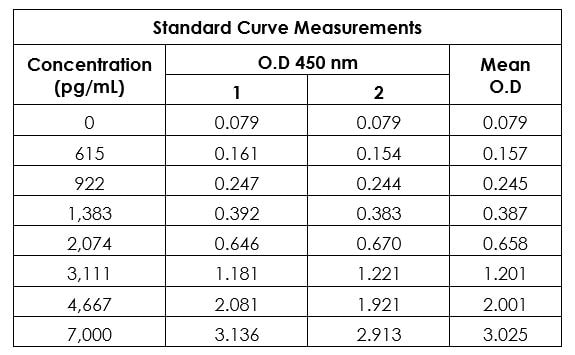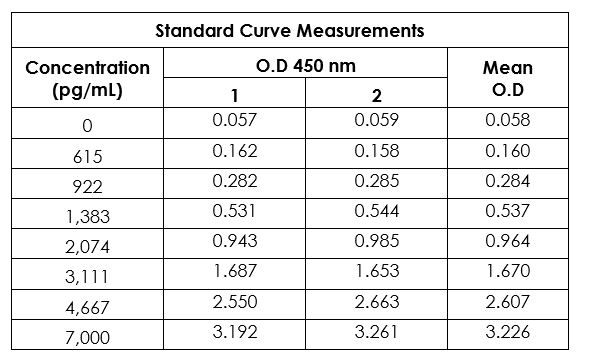Human Alpha-synuclein ELISA Kit (ab260052)
Key features and details
- One-wash 90 minute protocol
- Sensitivity: 504 pg/ml
- Range: 615 pg/ml - 7000 pg/ml
- Sample type: Cell culture media, Cell Lysate, Cit plasma, EDTA Plasma, Hep Plasma, Serum, Tissue Lysate
- Detection method: Colorimetric
- Assay type: Sandwich (quantitative)
- Reacts with: Human
Overview
-
Product name
Human Alpha-synuclein ELISA Kit
See all Alpha-synuclein kits -
Detection method
Colorimetric -
Precision
Intra-assay Sample n Mean SD CV% Serum 8 2.5% Inter-assay Sample n Mean SD CV% Serum 3 8.9% -
Sample type
Serum, Cell Lysate, Cell culture media, Hep Plasma, EDTA Plasma, Cit plasma, Tissue Lysate -
Assay type
Sandwich (quantitative) -
Sensitivity
504 pg/ml -
Range
615 pg/ml - 7000 pg/ml -
Recovery
Sample specific recovery Sample type Average % Range Serum 117 116% - 118% Cell culture media 103 90% - 114% Hep Plasma 106 93% - 115% EDTA Plasma 118 105% - 129% Cit plasma 113 113% - 113% -
Assay time
1h 30m -
Assay duration
One step assay -
Species reactivity
Reacts with: Human -
Product overview
Human Alpha-synuclein ELISA Kit (ab260052) is a single-wash 90 min sandwich ELISA designed for the quantitative measurement of Alpha-synuclein protein in cell culture media, cell lysate, cit plasma, edta plasma, hep plasma, and serum. It uses our proprietary SimpleStep ELISA® technology. Quantitate Human Alpha-synuclein with 504 pg/ml sensitivity.
SimpleStep ELISA® technology employs capture antibodies conjugated to an affinity tag that is recognized by the monoclonal antibody used to coat our SimpleStep ELISA® plates. This approach to sandwich ELISA allows the formation of the antibody-analyte sandwich complex in a single step, significantly reducing assay time. See the SimpleStep ELISA® protocol summary in the image section for further details. Our SimpleStep ELISA® technology provides several benefits:
- Single-wash protocol reduces assay time to 90 minutes or less
- High sensitivity, specificity and reproducibility from superior antibodies
- Fully validated in biological samples
- 96-wells plate breakable into 12 x 8 wells stripsA 384-well SimpleStep ELISA® microplate (ab203359) is available to use as an alternative to the 96-well microplate provided with SimpleStep ELISA® kits.
ASSAY SPECIFICITY
This kit recognizes both native and recombinant human Alpha-synuclein protein in serum, plasma, and cell culture supernatant, cell and tissue extract samples only.
Urine, saliva, and cerebrospinal fluid samples have not been tested with this kit.
CROSS REACTIVITY
Recombinant Tau 441, UCHL-1, beta-tubulin, and Gamma-synuclein were prepared at 7,000 pg/mL and assayed for cross reactivity. No cross-reactivity was observed.
INTERFERENCE
Recombinant Tau 441, UCHL-1, and beta tubulin were prepared at 4 ng/mL and tested for interference. No interference was observed.
SPECIES REACTIVITY
This kit recognizes human Alpha-synuclein protein.
Other species reactivity was determined by measuring 50% serum samples of various species, interpolating the protein concentrations from the human standard curve, and expressing the interpolated concentrations as a percentage of the protein concentration in human serum assayed at the same dilution.
This kit was found to react with rhesus macaque serum.
Reactivity
- Mouse
- Rat
- Cow
Other species reactivity not determined.
-
Notes
Alpha-synuclein is a 140- amino acid protein encoded by the SNCA gene, primarily found in neural tissue. It is a member of the synuclein family of proteins, including β-Synuclein and γ-Synuclein. Alpha-synuclein has been found concentrated in the presynaptic nerve terminals of neurons and has been found in the nucleus of neurons. Alpha-synuclein is a major component of Lewy Bodies. This protein appears to play a role in dopamine metabolism and vesicle trafficking.
Abcam has not and does not intend to apply for the REACH Authorisation of customers’ uses of products that contain European Authorisation list (Annex XIV) substances.
It is the responsibility of our customers to check the necessity of application of REACH Authorisation, and any other relevant authorisations, for their intended uses. -
Platform
Pre-coated microplate (12 x 8 well strips)
Properties
-
Storage instructions
Store at +4°C. Please refer to protocols. -
Components 1 x 96 tests 10X Human Alpha-synuclein Capture Antibody 1 x 600µl 10X Human Alpha-synuclein Detector Antibody 1 x 600µl 10X Wash Buffer PT (ab206977) 1 x 20ml 5X Cell Extraction Buffer PTR (ab193970) 1 x 10ml Antibody Diluent CPI - HAMA Blocker (ab193969) 1 x 6ml Human Alpha-synuclein Lyophilized Recombinant Protein (ab51189) 2 vials Plate Seals 1 unit Sample Diluent NS (ab193972) 1 x 50ml SimpleStep Pre-Coated 96-Well Microplate (ab206978) 1 unit Stop Solution 1 x 12ml TMB Development Solution 1 x 12ml -
Research areas
-
Function
May be involved in the regulation of dopamine release and transport. Induces fibrillization of microtubule-associated protein tau. Reduces neuronal responsiveness to various apoptotic stimuli, leading to a decreased caspase-3 activation. -
Tissue specificity
Expressed principally in brain but is also expressed in low concentrations in all tissues examined except in liver. Concentrated in presynaptic nerve terminals. -
Involvement in disease
Genetic alterations of SNCA resulting in aberrant polymerization into fibrils, are associated with several neurodegenerative diseases (synucleinopathies). SNCA fibrillar aggregates represent the major non A-beta component of Alzheimer disease amyloid plaque, and a major component of Lewy body inclusions. They are also found within Lewy body (LB)-like intraneuronal inclusions, glial inclusions and axonal spheroids in neurodegeneration with brain iron accumulation type 1.
Parkinson disease 1
Parkinson disease 4
Dementia Lewy body -
Sequence similarities
Belongs to the synuclein family. -
Domain
The 'non A-beta component of Alzheimer disease amyloid plaque' domain (NAC domain) is involved in fibrils formation. The middle hydrophobic region forms the core of the filaments. The C-terminus may regulate aggregation and determine the diameter of the filaments. -
Post-translational
modificationsPhosphorylated, predominantly on serine residues. Phosphorylation by CK1 appears to occur on residues distinct from the residue phosphorylated by other kinases. Phosphorylation of Ser-129 is selective and extensive in synucleinopathy lesions. In vitro, phosphorylation at Ser-129 promoted insoluble fibril formation. Phosphorylated on Tyr-125 by a PTK2B-dependent pathway upon osmotic stress.
Hallmark lesions of neurodegenerative synucleinopathies contain alpha-synuclein that is modified by nitration of tyrosine residues and possibly by dityrosine cross-linking to generated stable oligomers.
Ubiquitinated. The predominant conjugate is the diubiquitinated form.
Acetylation at Met-1 seems to be important for proper folding and native oligomeric structure. -
Cellular localization
Cytoplasm, cytosol. Membrane. Nucleus. Cell junction, synapse. Secreted. Membrane-bound in dopaminergic neurons. - Information by UniProt
-
Alternative names
- Alpha synuclein
- Alpha-synuclein
- Alpha-synuclein, isoform NACP140
see all -
Database links
- Entrez Gene: 6622 Human
- Omim: 163890 Human
- SwissProt: P37840 Human
- Unigene: 21374 Human
Images
-
SimpleStep ELISA technology allows the formation of the antibody-antigen complex in one single step, reducing assay time to 90 minutes. Add samples or standards and antibody mix to wells all at once, incubate, wash, and add your final substrate. See protocol for a detailed step-by-step guide.
-
Standard Curve comparison between the original Human Alpha-synuclein SimpleStep ELISA kit (ab210973) and current Human Alpha-synuclein SimpleStep ELISA kit (ab260052).
-
The Alpha-synuclein standard curve was prepared as described in Section 10. Raw data values are shown in the table. Background-subtracted data values (mean +/- SD) are graphed.
-
The Alpha-synuclein standard curve was prepared as described. Raw data values are shown in the table. Background-subtracted data values (mean +/- SD) are graphed.
-
The Alpha-synuclein standard curve was prepared as described. Raw data values are shown in the table. Background-subtracted data values (mean +/- SD) are graphed
-
The Alpha-synuclein standard curve was prepared as described. Raw data values are shown in the table. Background-subtracted data values (mean +/- SD) are graphed.
-
The concentrations of Alpha-synuclein were measured in duplicates, interpolated from the Alpha-synuclein standard curves and corrected for sample dilution. Undiluted samples are as follows: serum 100%, plasma (EDTA) 100%, plasma (citrate) 50% and plasma (heparin) 100%. The interpolated dilution factor corrected values are plotted (mean +/- SD, n=2). The mean Alpha-synuclein concentration was determined to be 6.6 ng/mL in serum, 6.8 ng/mL in plasma (EDTA), 13.6 ng/mL in plasma (citrate), and 7.1 ng/mL in plasma (heparin).
-
 Interpolated concentrations of native Alpha-synuclein in human brain and SH-SY5Y cell extract based on a 3 µg/mL and 500 µg/mL extract load, respectfully.
Interpolated concentrations of native Alpha-synuclein in human brain and SH-SY5Y cell extract based on a 3 µg/mL and 500 µg/mL extract load, respectfully.The concentrations of Alpha-synuclein were measured in duplicate and interpolated from the Alpha-synuclein standard curve and corrected for sample dilution. The interpolated dilution factor corrected values are plotted (mean +/- SD, n=2).
-
Interpolated dilution factor corrected values are plotted (mean +/- SD, n=2). The mean Alpha-synuclein concentration was determined to be 7.8 ng/mL with a range of 3.0 – 8.9 ng/mL.
-
Raw data is plotted for wild-type and alpha synuclein-knockout HAP1 cell extracts tested at 111 μg/mL.
-
The MDD was determined by calculating the mean of zero standard replicates and adding 2 standard deviations then extrapolating the corresponding concentration.
-
Linearity of dilution is determined based on interpolated values from the standard curve. Linearity of dilution defines a sample concentration interval in which interpolated target concentrations are directly proportional to sample dilution.
Native Alpha-synuclein was measured in the following biological samples in a 1.5-fold dilution series. Sample dilutions are made in Sample Diluent NS.
-
Linearity of dilution is determined based on interpolated values from the standard curve. Linearity of dilution defines a sample concentration interval in which interpolated target concentrations are directly proportional to sample dilution.
Native Alpha-synuclein was measured in the following biological samples in a 1.5-fold dilution series. Sample dilutions are made in Sample Diluent 1X Cell Extraction Buffer PTR.
Recombinant Alpha-synuclein protein was spiked into RPMI media containing 10% FBS in a 1.5 -fold dilution series. Serial dilutions are made in Sample Diluent NS.
-
To learn more about the advantages of recombinant antibodies see here.

































